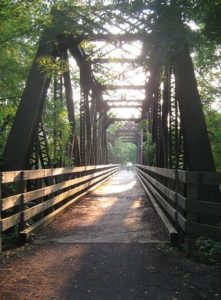You may recall that we have written about the complexity of the real estate issues associated with rails-to-trails projects before. To review, in 1983 Congress amended the National Trails System Act to preserve rail corridors and encourage energy-efficient modes of transportation. Section 8(d), Interim use of railroad rights-of-way, allowed a railroad to transfer an unprofitable rail line to a qualified agency for interim use as a trail until the line is needed again for rail service. This transfer is referred to as “railbanking.” In this post, we will focus on the increasingly common property rights litigation that has resulted from the federal Rails-to-Trails Program.

Pine Creek Rail Trail Bridge in Waterville, courtesy of Ruhrfisch.
The Rails-to-Trails Program has been moderately successful in meeting its goals. According to the Rails-to-Trails Conservancy, a rails-to-trails advocacy organization, there are now more than 20,000 miles of rail-trails throughout the country, and almost half again as many miles of potential rail-trails waiting to be built.[1] However, these trails have had an unanticipated cost.
The Rails-to-Trails Program has caused considerable litigation against the U.S. government because many railroads don’t possess fee simple title to their rights-of-way, but instead, hold them under easements or other property interests. It may take considerable research to determine how the railroad acquired the rights to the corridor, but if the railroad’s easements were limited to railroad uses, then those easements would be extinguished when the railroad abandoned the property, thus unburdening the underlying fee title, which is typically owned by the abutting landowners. When these landowners see the railroad cease operations, they assume that the right-of-way has been abandoned and will revert to them under the terms of the easement. However, in the 1983 railbanking amendments, Congress specified that interim trail use does not constitute abandonment. So, because the right-of-way would have reverted to the abutting landowners but for the trail use, and will not revert to them due to the trail use, plaintiffs maintain that their property has been taken and they are due just compensation.[2]
According to Mr. Tom Sansonetti, the Assistant Attorney General in charge of the Environment and Natural Resources Division of the U.S. Department of Justice (DOJ), the problem continues to expand. In 1990, Mr. Sansonetti’s division was litigating one rails-to-trails case against one claimant, but by 2002, there were 17 cases with 4,550 claimants. Now, there are about 80 cases pending with 8,000 claimants. The plaintiffs’ lawyers predict that the liability for taxpayers could exceed $500 million.[3]
These costs were apparently not anticipated—the original Congressional Budget Office estimate of federal costs for the 1983 railbanking amendments was $0. In addition, because all of the DOJ funds expended to litigate these cases are paid out of the Judgment Fund, Congress has no real opportunity for budget or appropriations review.[2]
In part 2, we will discuss more of the problems and controversies surrounding rails-to-trails litigation.





Trackbacks/Pingbacks